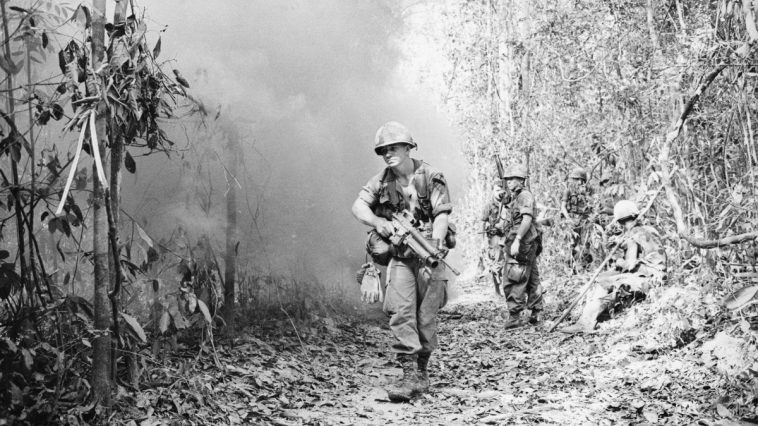Who were the Khmer Bleu? If you are reading this, I will assume you know exactly who the Khmer Rouge are, but just in case we will give some backstory.
The Khmer are the majority people that inhabit what we call Cambodia. Cambodia themselves call their country Kampuchea, something that would come to play when Pol Pot eventually took over the country.
King Sihanouk then running the country as a one party state referred to leftist Cambodians as Khmer Rouge, rouge meaning red in the Khmer language, so “Red Cambodians”.
In later times the phrase specifically pertained to the regime and insurgency of Pol Pot, an irony during the 1980’s then Cambodia was under an actual communist government, namely the Peoples Republic of Kampuchea.
To read about the SEA Games in Cambodia click here.
Who were the Khmer Bleu?
Essentially the Khmer Bleu, or Blue Cambodians were the polar opposite of the Khmer Rouge. The Khmer Bleu, or to give them their correct title The Khmer Serei (Khmer: ខ្មែរសេរី) were thus a blue, or right-wing insurgency in Cambodia that existed until the overthrow of King Sihanouk in 1970.
Their name was also coined by Sihanouk and meant in a derogatory way, but their defeat is no longer in popular parlance, nor is much known about the organization.
What were the Khmer Serei?

Much like the Khmer Rouge were in actual fact the Communist Party of Kampuchea, the Khmer Bleu were in fact the Khmer Serei.
The rebel group ironically comes from the same lineage as the Khmer Rouge, both having their roots in the anti-colonial struggle of the Khmer Issarak. Initially, this group consisted of people across the political spectrum, but as Vietnamese influence increased so did the leftist nature of the group.
This led to schisms and the founding of the group by Khmer nationalist Son Ngoc Thanh. In 1959 he published ‘The Manifesto of the Khmer Serei’. This document claimed that Sihanouk was turning Cambodia “communistic”. At the time Cambodia was ruled under Sihanouk’s “Buddhist Socialist “ principles. He also enjoyed cordial ties with China and North Korea, communist though he very much was not.
To read about the friendship between Sihanouk and Kim Il-Sung click here.
His group thus started a paradoxical anti-royalist and anti-communist insurgency ironically filed and funded by the Kingdom of Thailand and perhaps less ironically alleged support from the Central Inelegance Agency (CIA).
Was Sihanouk too leftist?
Quite simply no he wasn’t, but this should also be seen through the prism of cold war history. He was friends with China and North Korea, as well as holding cordial relations with the Vietnamese. Overall though he was neutral trying to keep Cambodia out of big power politics.
At the time though this was not how the west saw it and essentially an “If you’re not with us you’re against us” mentality ensued.
Yet while the Khmer Bleu hated Sihanouk he seemed to hate them even more, seeing their existence as an almost personal affront. There is much documented evidence of massacres against members of the group.
In reality, the group was never a threat to the regime, with those who were communists siding with the Khmer Rouge and those who were not preferring the status quo, something which would only change with the formation of the Khmer Republic.
The end of the Khmer Bleu
The group as any kind of force ended in 1969 when they defected from their bases in South Vietnam to the Royal Cambodian government. Why they did this has been left open to much scholarly debate.
Both theories though essentially state that they were sent as Trojan horses either by Son Ngoc Thanh, or the CIA as trojan horses against the army of Sihanouk. Both hold credence as by the following year Lon Nol had overthrown the government and created the Khmer Republic.
The Khmer Seriei were duly disbanded by Son Ngoc Thanh who unsurprisingly pledged support for the new republican government. The Khmer Bleu officially at least were no more.
The Khmer Bleu and the victory of Pol Pot
Ironically it was Khmer Bleu support for the republic and anti-Sihanouk sentiment that threw the popular leader into the holy alliance with the Khmer Rouge. With hindsight, they surely had more in common with Sihanouk than the Khmer Rouge did.
Alas despite their anti-communist rhetoric they were to be a driving force in the victory of the Khmer Rouge under the titular leadership of Sihanouk, the slaughter that followed, as well as the morphing of the country into the Vietnamese dominated People’s Republic of Kampuchea.
Son Ngoc Thanh fled to Saigon where he was captured after its fall and was to eventually die in prison. Any other members left in the country would have likely perished under the Pol Pot regime, being the very epitome of what they considered traitors to the country.
Son Ngoc Thanh is a largely forgotten figure now, with those that do remember him seeing him largely as a foreign puppet.

